The Royal Humane Society
World First Aid Day, introduced by the International Federation of Red Cross and Red Crescent Societies (IFRC), falls on the second Saturday of September and aims to raise awareness of how first aid can save lives. Such a day seems like an appropriate time to highlight an item relating to saving lives from one of our business collections.
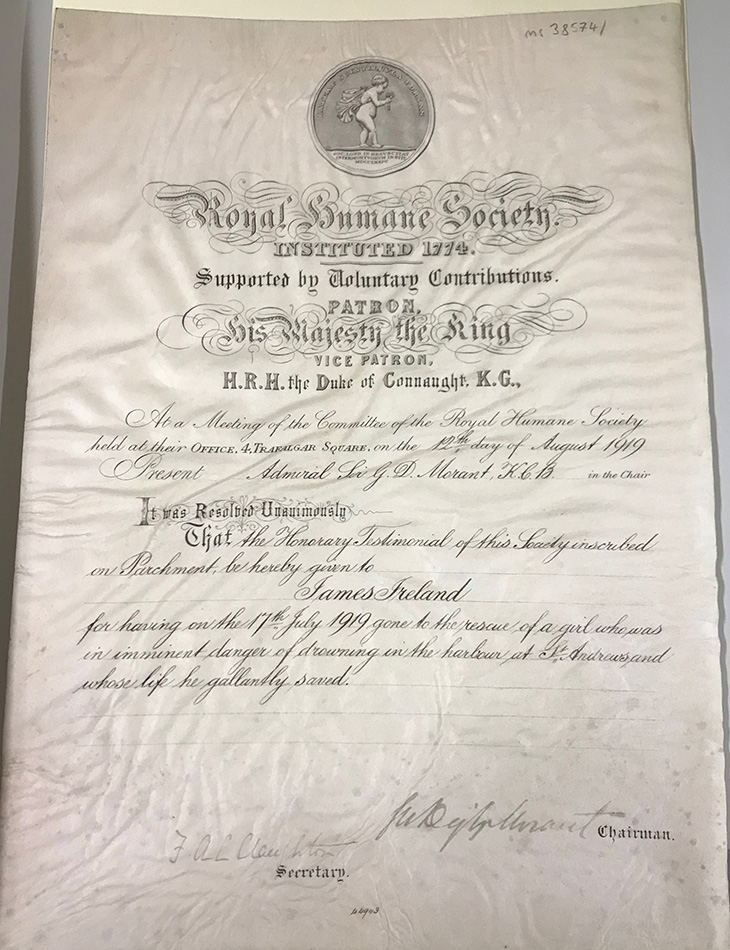
Among the business papers of Ireland and Ireland – cabinet makers and later a furniture retailing business in St Andrews – is an unexpected testimonial from the Royal Humane Society (RHS) dated 1919. While most of the collection relates to the Ireland family business, this award was presented to James Ireland for his act of bravery in rescuing a little girl from drowning in St Andrews harbour on the 17th July 1919. The local news reports of the time stated that:
Davina Stevenson, aged 11 years, fell into the upper harbour, and but for the plucky and timely action of Mr James Ireland would have been drowned. Mr Ireland, when working at his yacht, noticed something floating on the water, and discovering that it was a girl, at once entered the water and rescued her. His jacket pockets were full of tools at the time, but he did not stay to divest himself of any of his clothing…She was in serious condition but was successfully brought round. Had she been much longer in the water, she would probably have succumbed.
St Andrews Citizen, 26 July 1919
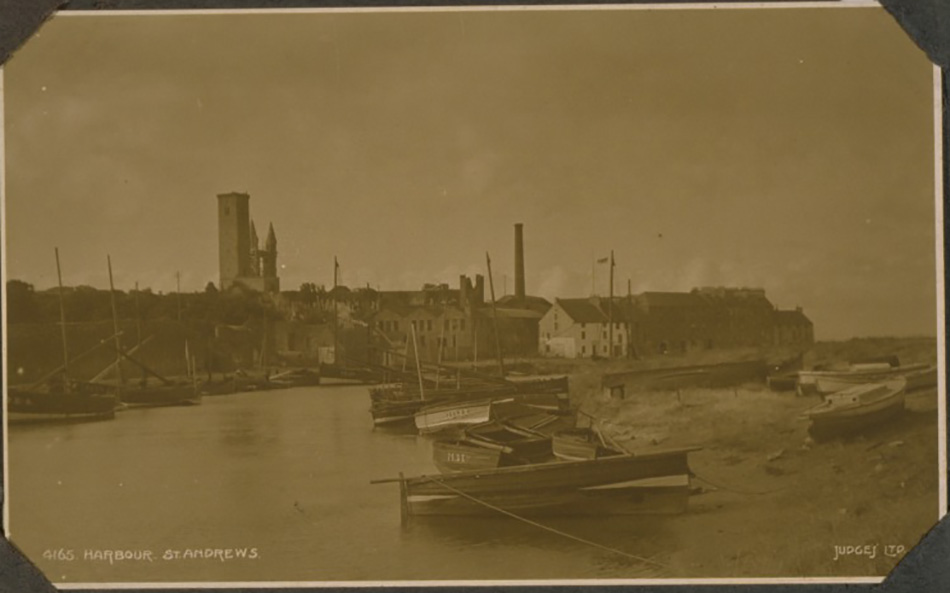
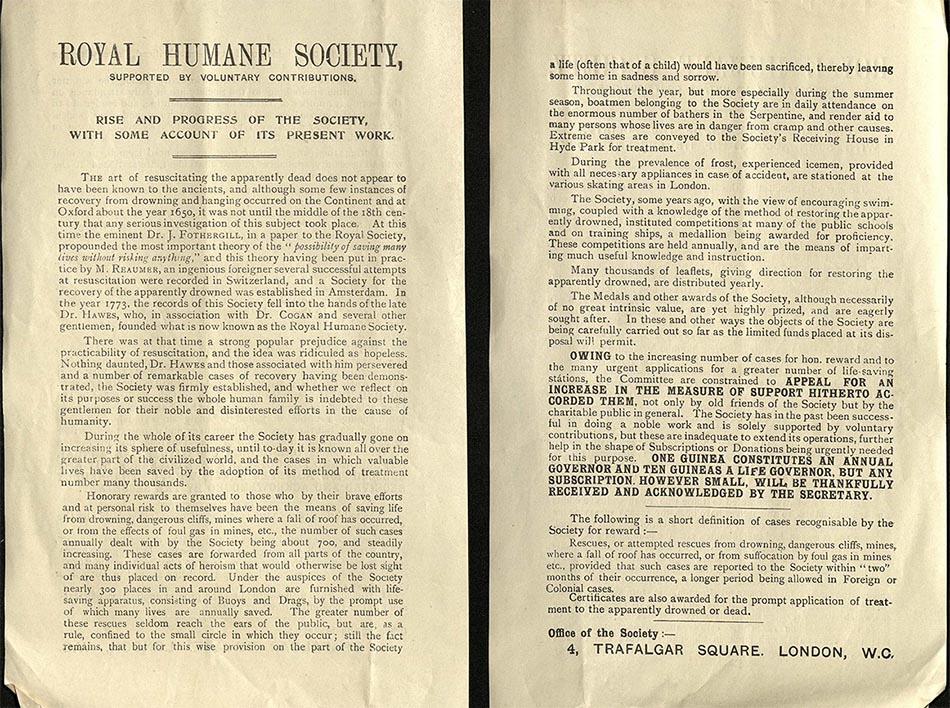
The Royal Humane Society (originally the Society for the Recovery of Persons Apparently Drowned until 1776), was founded in 1774 by Dr William Hawes and Dr Thomas Cogan, who were keen to promote techniques of resuscitation, a practice at the time which was ridiculed by some as hopeless. The purpose of the society was to publish information on how to save people from drowning and to recognise the efforts of those, such as James Ireland, who had risked their own lives to save others. The RHS also awarded St Andrews Divinity student John Honey with a medal for his heroic efforts in saving five crew members from the wreck of the Janet of Macduff in St Andrews Bay in 1800.

One of the founding members of RHS, Cogan, had been inspired by the Society for the Recovery of Drowned Persons in Amsterdam, formed in 1767 and translated the paper, Memoirs of the Society instituted at Amsterdam in favour of Drowned Persons, 1767-71, from Dutch into English. In addition to offering financial rewards to those who attempted and saved individuals from drowning, with his colleague William Hawes, Cogan established a group of surgeons and apothecaries to assist drowning victims along the River Thames. The Royal Humane Society continues to this day and while it no longer offers advice on life saving or resuscitation still aims to recognise the efforts of those who have tried to save lives.
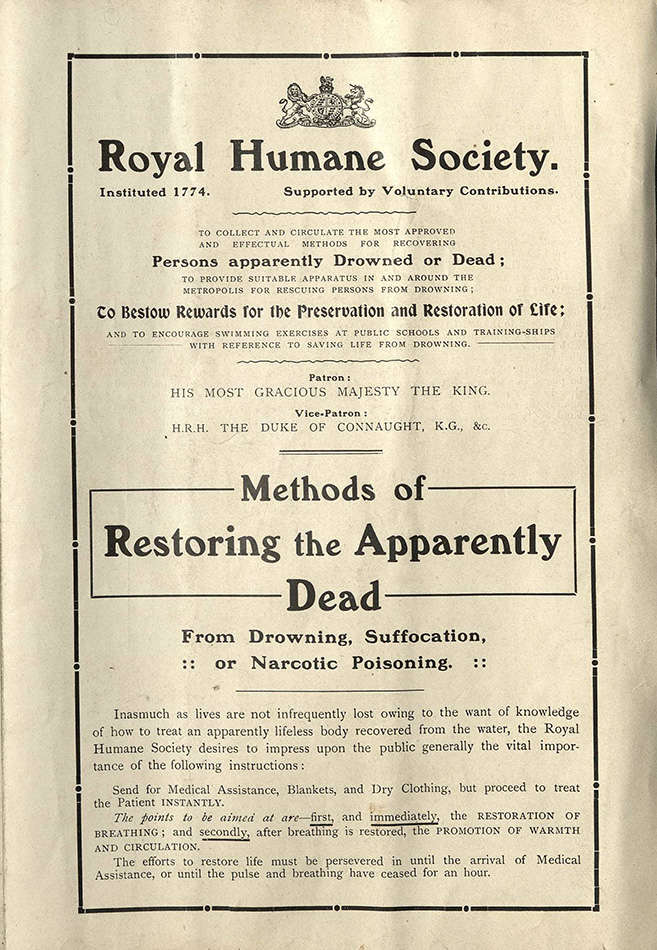
A few of the pamphlets published by the Society are also to be found with Ireland’s certificate, containing advice on how to save individuals from drowning and methods for resuscitation. One has the rather sinister title of ‘Methods for Restoring the Apparently Dead’ and includes instructions for the public on how to restore breathing.
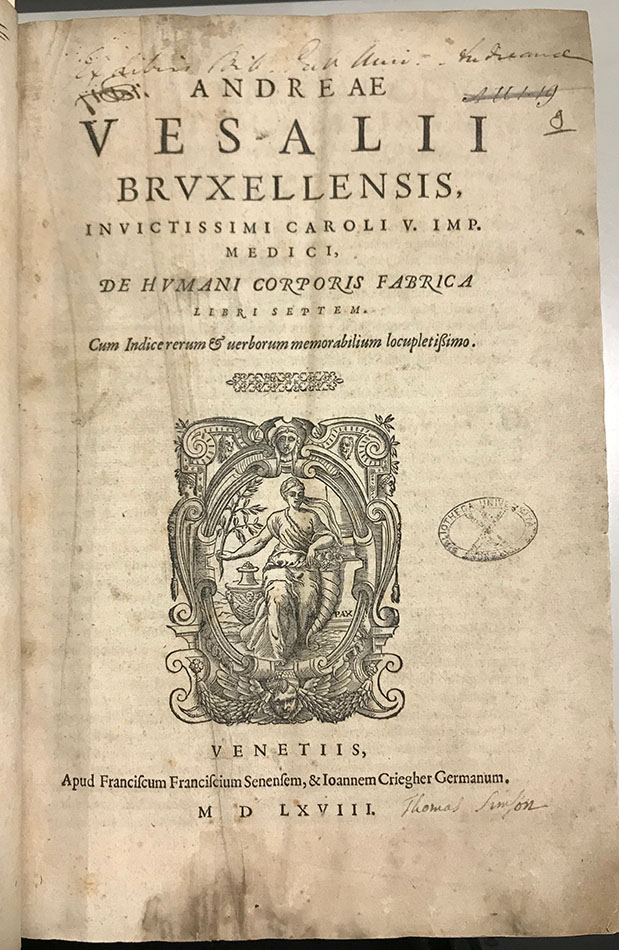
The history of artificial respiration can be traced back to Andreas Vesalius and his work De Humani Corporis Fabrica first published in 1543. In Book VII he described his technique for keeping an animal alive through surgical airways and artificial ventilation. At the Royal Society in the 17th century, Robert Hooke also demonstrated artificial respiration with the use of animals. However, according to a Royal Humane Society leaflet, it wasn’t until the 18th century that the ‘resuscitation of the apparently dead’ was seriously investigated.
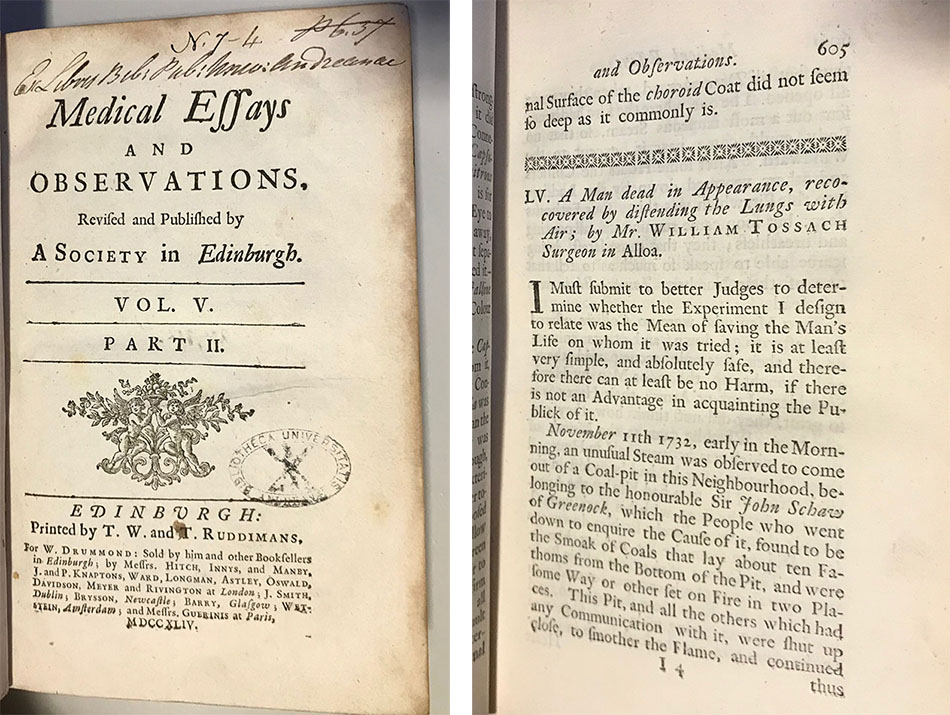
Scottish doctor William Tossach used mouth to mouth resuscitation in Alloa in 1732, saving the life of a local miner James Blair who was thought dead after a fire. Tossach’s account was published in Medical essays and observations in 1744. Inspired by this account, Dr J Fothergill, mentioned in the RHS’s leaflet on the ‘Rise and progress of the Society’, lectured the Royal Society on the Alloa case and the practice of mouth to mouth resuscitation. The French Academy of Sciences officially recommended in 1740 that mouth to mouth be used with drowning victims. Yet, the practice fell out of use in Britain, viewed by some as vulgar, in favour of artificial respiration using bellows.[1]
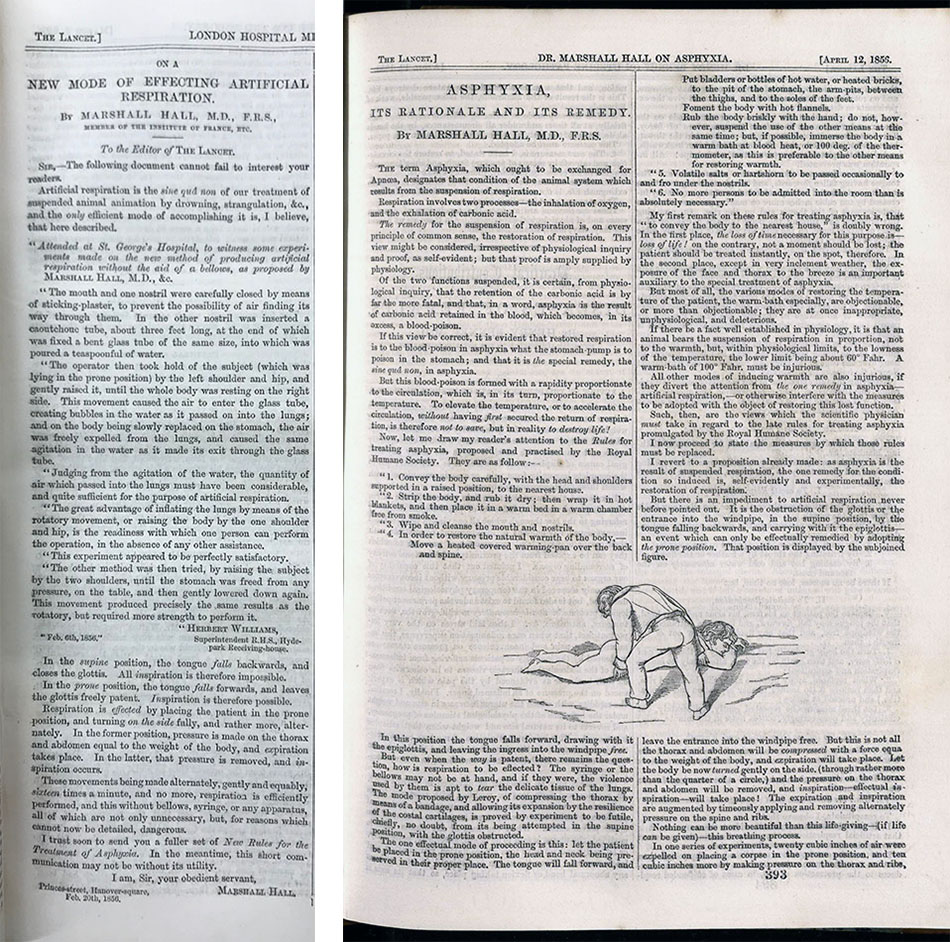
The recommendations of the RHS for resuscitation changed over the years. In the 18th century techniques included the use of various equipment, such as bellows and smelling salts, and at one-point electricity. By the 19th century, resuscitation practices shifted to external manipulations of the chest, such as the prone position proposed Dr Marshall Hall in 1856 in his Lancet article Asphyxia Its Rational and its Remedy. In his fuller article Hall criticises what he sees as the Royal Humane Society’s incorrect recommendations of the time. Dr Henry Robert Silvester just a couple of years later published his technique of placing a patient on their back with arms up, known as the ‘natural method’. Support in the medical profession was divided between Hall and Silvester – though a committee of the Royal Medical and Chirurgical Society reported in favour of Silvester in 1862. Silvester received the Fothergill Gold Medal from the Royal Humane Society in 1883 and it is his technique that is included in the RHS leaflet below.
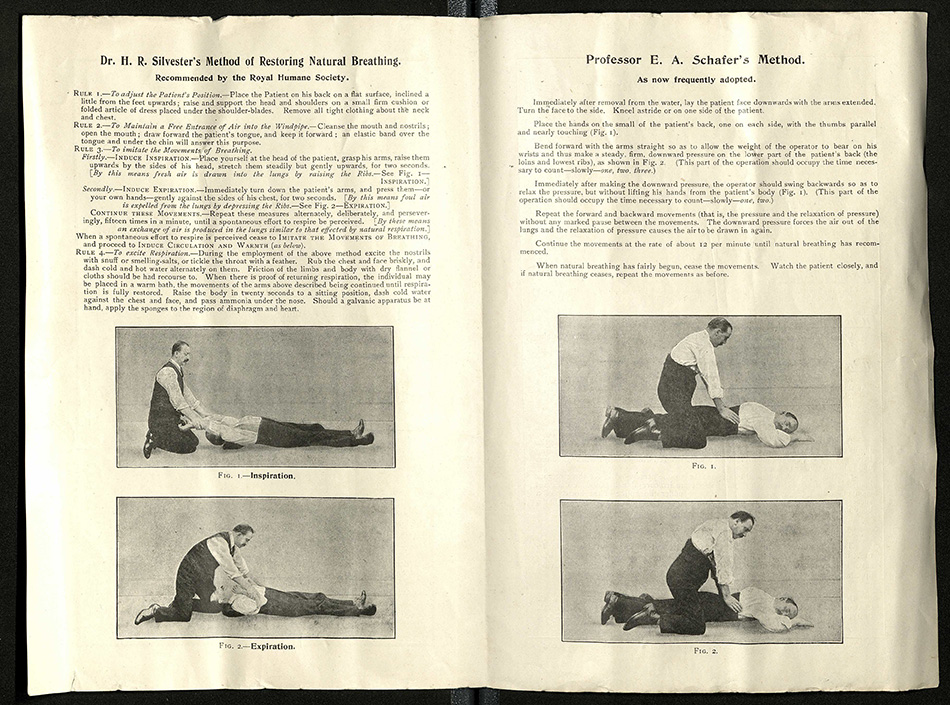
Featured in the same RHS leaflet is the technique introduced by Sir Edward Albert Sharpey-Schafer in 1903. In the Schafer method, also known as the ‘prone pressure’ method, the patient is face down with pressure applied to the lower thorax. Schafer’s method became the preferred form of resuscitation and was taught by the Red Cross for many years. It wasn’t until the 1950s, after its introduction by Dr James Elam and Dr Peter Safar, that mouth to mouth resuscitation, and cardiopulmonary resuscitation (CPR) in the 1960s became the preferred techniques for resuscitation.
For information about current recommended first aid take a look at the NHS guide and British Red Cross guides.
Finding these Royal Humane Society items in a business collection is a perfect example of one of the joys of how varied archive cataloguing can be!
Sarah Rodriguez
Assistant Archivist (Modern Records)
[1] Douglas Chamberlain, ‘Never Quite There: a tale of Resuscitation Medicine’, Resuscitation, 60:1, 2004, pp 3-11.